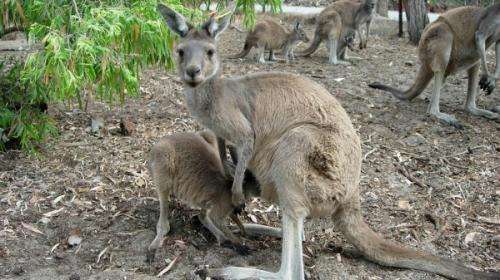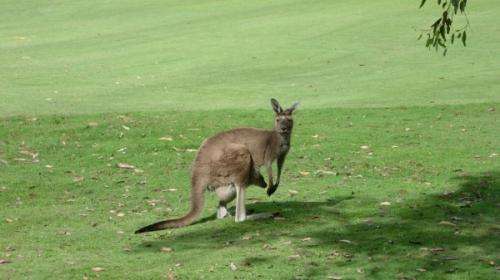Contaminant testing method considered via roo study

A simple, cost-effective method of testing the activity of a certain enzyme in animals may help people working with limited resources in the third world or rural WA locations easily detect ecosystem contaminants which have affected certain animals.
The enzyme, plasma cholinesterase (PCE) is present inside domestic and wild animals and can be negatively affected by environmental contaminants, in particular organophosphate insecticides (OP's).
Organophosphate insecticides are often used to combat lice in livestock or broad-acre spraying of large crops, which may drift and cause water sources to be contaminated.
UWA Animal Welfare Officer Dr Chris Mayberry tested the PCE activity of six mammalian species in a recent study into kangaroo management.
"OPs interfere with the body's levels of PCE. If the dose of OP is high enough, it will kill the animal, but at low doses, the animal may appear, in the short-term, to be unaffected," he says.
"However, repeated or chronic low-level exposure might lead to ill health in the long-term, and animals may be an indicator of what is happening to people who live near them."
Dr Mayberry says using this method in a third world rural setting would involve testing some samples from cattle upwind or upstream and comparing those results with the results for your animals of interest.
This method requires only basic laboratory equipment, estimated at a cost under $450, making PCE testing much more accessible for laboratories in countries without access to first world equipment.

Dr Mayberry says while the method is labour intensive, it has large cost benefits.
"You can only process one sample at a time, and each one can take half an hour," he says.
"Modern laboratories will usually be set up to process dozens, if not hundreds, of samples at once, but the machinery is very expensive."
The pH titration method used by Dr Mayberry requires few, easily acquired resources, including a pH meter, digital scales and solutions of hydrochloric acid and sodium hydroxide.
Once an animal is captured and a blood sample taken, the plasma is separated through centrifugation and tested.
"Essentially, plasma cholinesterase breaks down one chemical involved in nerve transmission, acetylcholine, into acetic acid and choline," Dr Mayberry says.
"Each molecule of acetic acid reduces the pH of a liquid mixture by a known amount."
"So the activity level of PCE in the blood can be measured by the pH change over time, which is a reflection of the amount of acetic acid that is produced."
Provided by Science Network WA


















